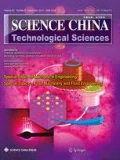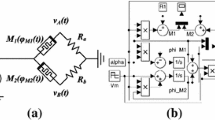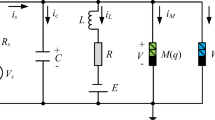Abstract
Electromagnetic induction effect caused by neuron potential can be mimicked using memristor. This paper considers a flux-controlled memristor to imitate the electromagnetic induction effect of adapting feedback synapse and presents a memristive neuron model with the adapting synapse. The memristive neuron model is three-dimensional and non-autonomous. It has the time-varying equilibria with multiple stabilities, which results in the global coexistence of multiple firing patterns. Multiple numerical plots are executed to uncover diverse coexisting firing patterns in the memristive neuron model. Particularly, a nonlinear fitting scheme is raised and a fitting activation function circuit is employed to implement the memristive mono-neuron model. Diverse coexisting firing patterns are observed from the hardware experiment circuit and the measured results verify the numerical simulations well.
Similar content being viewed by others
References
Sah M P, Kim H, Chua L O. Brains are made of memristors. IEEE Circuits Syst Mag, 2014, 14: 12–36
Ma J, Yang Z, Yang L, et al. A physical view of computational neurodynamics. J Zhejiang Univ Sci A, 2019, 20: 639–659
Hodgkin A L, Huxley A F. A quantitative description of membrane current and its application to conduction and excitation in nerve. J Physiol, 1952, 117: 500–544
Chua L. If it’s pinched it’s a memristor. Semicond Sci Technol, 2014, 29: 104001
Bao B, Yang Q, Zhu L, et al. Chaotic bursting dynamics and coexisting multistable firing patterns in 3D autonomous Morris-Lecar model and microcontroller-based validations. Int J Bifurcation Chaos, 2019, 29: 1950134
Rajamani V, Kim H, Chua L. Morris-Lecar model of third-order barnacle muscle fiber is made of volatile memristors. Sci China Inf Sci, 2018, 61: 060426
Azghadi M R, Linares-Barranco B, Abbott D, et al. A hybrid CMOS-memristor neuromorphic synapse. IEEE Trans Biomed Circuits Syst, 2017, 11: 434–445
Bao H, Hu A, Liu W, et al. Hidden bursting firings and bifurcation mechanisms in memristive neuron model with threshold electromagnetic induction. IEEE Trans Neural Netw Learning Syst, 2020, 31: 502–511
Chen C J, Chen J Q, Bao H, et al. Coexisting multi-stable patterns in memristor synapse-coupled Hopfield neural network with two neurons. Nonlinear Dyn, 2019, 95: 3385–3399
Wang C N, Tang J, Ma J. Minireview on signal exchange between nonlinear circuits and neurons via field coupling. Eur Phys J Spec Top, 2019, 228: 1907–1924
Lu L L, Jia Y, Xu Y, et al. Energy dependence on modes of electric activities of neuron driven by different external mixed signals under electromagnetic induction. Sci China Tech Sci, 2019, 62: 427–440
Lv M, Wang C N, Ren G D, et al. Model of electrical activity in a neuron under magnetic flow effect. Nonlinear Dyn, 2016, 85: 1479–1490
Ma J, Tang J. A review for dynamics of collective behaviors of network of neurons. Sci China Tech Sci, 2015, 58: 2038–2045
Wu F Q, Wang C N, Jin W Y, et al. Dynamical responses in a new neuron model subjected to electromagnetic induction and phase noise. Phys A-Stat Mech Appl, 2017, 469: 81–88
Zhao Y, Sun X Y, Liu Y, et al. Phase synchronization dynamics of coupled neurons with coupling phase in the electromagnetic field. Nonlinear Dyn, 2018, 93: 1315–1324
Hong Q H, Zhao L, Wang X P. Novel circuit designs of memristor synapse and neuron. Neurocomputing, 2019, 330: 11–16
Lv M, Ma J, Yao Y G, et al. Synchronization and wave propagation in neuronal network under field coupling. Sci China Tech Sci, 2019, 62: 448–457
Wang Z R, Joshi S, Savel’ev S E, et al. Memristors with diffusive dynamics as synaptic emulators for neuromorphic computing. Nat Mater, 2017, 16: 101–108
Yan B N, Chen Y R, Li H. Challenges of memristor based neuromorphic computing system. Sci China Inf Sci, 2018, 61: 060425
Mostaghimi S, Nazarimehr F, Jafari S, et al. Chemical and electrical synapse-modulated dynamical properties of coupled neurons under magnetic flow. Appl Math Comput, 2019, 348: 42–56
Wang Y, Ma J, Xu Y, et al. The electrical activity of neurons subject to electromagnetic induction and Gaussian white noise. Int J Bifurcation Chaos, 2017, 27: 1750030
Rostami Z, Jafari S, Perc M, et al. Elimination of spiral waves in excitable media by magnetic induction. Nonlinear Dyn, 2018, 94:679–692
Bao B, Hu A, Bao H, et al. Three-dimensional memristive Hindmarsh-Rose neuron model with hidden coexisting asymmetric behaviors. Complexity, 2018, 2018: 1–11
Ge M Y, Jia Y, Xu Y, et al. Mode transition in electrical activities of neuron driven by high and low frequency stimulus in the presence of electromagnetic induction and radiation. Nonlinear Dyn, 2018, 91: 515–523
Bao H, Zhang Y, Liu W, et al. Memristor synapse-coupled memristive neuron network: Synchronization transition and occurrence of chimera. Nonlinear Dyn, 2020, 100: 937–950
Xu F, Zhang J, Fang T, et al. Synchronous dynamics in neural system coupled with memristive synapse. Nonlinear Dyn, 2018, 92: 1395–1402
Xu Y, Jia Y, Ge M Y, et al. Effects of ion channel blocks on electrical activity of stochastic Hodgkin-Huxley neural network under electromagnetic induction. Neurocomputing, 2018, 283: 196–204
Parastesh F, Rajagopal K, Alsaadi F E, et al. Birth and death of spiral waves in a network of Hindmarsh-Rose neurons with exponential magnetic flux and excitable media. Appl Math Comput, 2019, 354: 377–384
Chen M, Qi J W, Wu H G, et al. Bifurcation analyses and hardware experiments for bursting dynamics in non-autonomous memristive FitzHugh-Nagumo circuit. Sci China Tech Sci, 2020, 63: 1035–1044
Zandi-Mehran N, Jafari S, Hashemi Golpayegani S M R, et al. Different synaptic connections evoke different firing patterns in neurons subject to an electromagnetic field. Nonlinear Dyn, 2020, 100: 1809–1824
Shafiei M, Jafari S, Parastesh F, et al. Time delayed chemical synapses and synchronization in multilayer neuronal networks with ephaptic inter-layer coupling. Commun Nonlinear Sci Numer Simul, 2020, 84: 105175
Jin W Y, Wang A, Ma J, et al. Effects of electromagnetic induction and noise on the regulation of sleep wake cycle. Sci China Tech Sci, 2019, 62: 2113–2119
Shi S, Xiao M, Rong L N, et al. Stability and bifurcation control ofa neuron system under a novel fractional-order PD controller. Sci China Tech Sci, 2019, 62: 2120–2129
Bao H, Liu W B, Chen M. Hidden extreme multistability and dimensionality reduction analysis for an improved non-autonomous memristive FitzHugh-Nagumo circuit. Nonlinear Dyn, 2019, 96: 1879–1894
Ma J, Wu F Q, Ren G D, et al. A class of initials-dependent dynamical systems. Appl Math Comput, 2017, 298: 65–76
Bao H, Chen M, Wu H G, et al. Memristor initial-boosted coexisting plane bifurcations and its extreme multi-stability reconstitution in two-memristor-based dynamical system. Sci China Tech Sci, 2020, 63: 603–613
Jafari S, Ahmadi A, Panahi S, et al. Extreme multi-stability: When imperfection changes quality. Chaos Solitons Fractals, 2018, 108: 182–186
Chen M, Sun M, Bao H, et al. Flux-charge analysis of two-memristor-based Chua’s circuit: Dimensionality decreasing model for detecting extreme multistability. IEEE Trans Ind Electron, 2020, 67: 2197–2206
Bennett D J, Li Y, Harvey P J, et al. Evidence for plateau potentials in tail motoneurons of awake chronic spinal rats with spasticity. J Neurophysiol, 2001, 86: 1972–1982
Bao B, Hu A, Xu Q, et al. AC-induced coexisting asymmetric bursters in the improved Hindmarsh-Rose model. Nonlinear Dyn, 2018, 92: 1695–1706
Pisarchik A N, Jaimes-Reátegui R, García-Vellisca M A. Asymmetry in electrical coupling between neurons alters multistable firing behavior. Chaos, 2018, 28: 033605
Dong D W, Hopfield J J. Dynamic properties of neural networks with adapting synapses. Network-Comput Neural Syst, 1992, 3: 267–283
Li C G, Chen G R. Coexisting chaotic attractors in a single neuron model with adapting feedback synapse. Chaos Solitons Fractals, 2005, 23: 1599–1604
Bao B C, Zhu Y X, Li C Q, et al. Global multistability and analog circuit implementation of an adapting synapse-based neuron model. Nonlinear Dyn, 2020, 101: 1105–1118
Hu X F, Feng G, Duan S K, et al. A memristive multilayer cellular neural network with applications to image processing. IEEE Trans Neural Netw Learn Syst, 2017, 28: 1889–1901
Jiang Y N, Huang P, Zhu D B, et al. Design and hardware implementation of neuromorphic systems with RRAM synapses and threshold-controlled neurons for pattern recognition. IEEE Trans Circuits Syst I, 2018, 65: 2726–2738
Binczak S, Kazantsev V B, Nekorkin V I, et al. Experimental study of bifurcations in modified FitzHugh-Nagumo cell. Electron Lett, 2003, 39: 961–962
Hayati M, Nouri M, Haghiri S, et al. Digital multiplierless realization of two coupled biological Morris-Lecar neuron model. IEEE Trans Circuits Syst I, 2015, 62: 1805–1814
Jokar E, Abolfathi H, Ahmadi A, et al. An efficient uniform-segmented neuron model for large-scale neuromorphic circuit design: Simulation and FPGA synthesis results. IEEE Trans Circuits Syst I, 2019, 66: 2336–2349
Matsuda C, Torikai H. A novel generalized PWC neuron model: Theoretical analyses and efficient design ofbifurcation mechanisms of bursting. IEEE Trans Circuits Syst II, 2018, 65: 1738–1742
Bao B C, Hou L P, Zhu Y X, et al. Bifurcation analysis and circuit implementation for a tabu learning neuron model. AEU-Int J Electron Commun, 2020, 121: 153235
Rech P C. Period-adding and spiral organization of the periodicity in a Hopfield neural network. Int J Mach Learn Cyber, 2015, 6: 1–6
Cairone F, Gagliano S, Bucolo M. Experimental study on the SLUG flow in a serpentine microchannel. Exp Thermal Fluid Sci, 2016, 76: 34–44
Li H Z, Hua Z Y, Bao H, et al. Two-dimensional memristive hyperchaotic maps and application in secure communication. IEEE Trans Ind Electron, 2020, 2020: 1
Author information
Authors and Affiliations
Corresponding author
Additional information
This work was supported by the National Natural Science Foundation of China (Grant Nos. 51777016 and 61801054), and the Natural Science Foundation of Jiangsu Province, China (Grant No. BK20191451).
Rights and permissions
About this article
Cite this article
Bao, B., Zhu, Y., Ma, J. et al. Memristive neuron model with an adapting synapse and its hardware experiments. Sci. China Technol. Sci. 64, 1107–1117 (2021). https://doi.org/10.1007/s11431-020-1730-0
Received:
Accepted:
Published:
Issue Date:
DOI: https://doi.org/10.1007/s11431-020-1730-0




